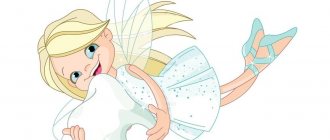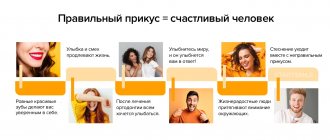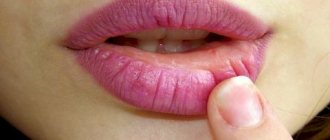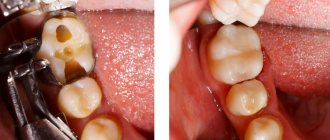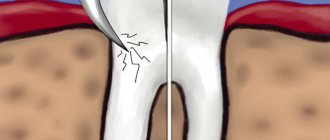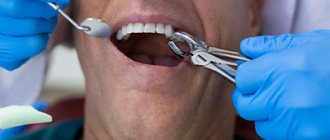Features of tooth extraction in children
Pediatric dentistry is focused on the treatment and prevention of oral diseases. In this case, psychological support for the baby is important. Specialists must act delicately, instilling trust and relieving the child of fears. This is especially important in case of forced tooth extraction. Therefore, there are several unspoken rules of the pediatric dentist.
- Do not use the word “pain” or the particle “not.” Children do not accept denial and react sharply to unpleasant phrases.
- Do not discuss the details of the procedure in the office. Medical terms and unfamiliar words frighten the baby.
- Try to hide dental instruments from the eyes of the small patient. Forceps, packages of syringes and drill attachments can drive even the most courageous tomboy into hysterics.
This procedure requires high professionalism and great care from the doctor. With one careless movement, he can damage the germ of a new tooth and the tissue of the socket, which will cause a delay in eruption and various dentofacial deviations.
General indications for tooth extraction in children
The child’s dentition is formed according to certain patterns: the incisors erupt first, followed by the molars. Then the baby teeth are gradually replaced by permanent teeth. If this process occurs correctly, without deviations from the norm, there is no need to specifically remove baby teeth. However, there are situations when this is necessary:
- advanced caries;
- the last stage of development of a cyst on the gum;
- severe tooth injury;
- a tooth that fails to develop and erupt.
Removing a child’s front tooth is a particularly unpleasant procedure, as the aesthetics of the smile suffers. Usually, surgery is resorted to in the following circumstances:
- exposure of the pulp due to a fracture of the coronal part;
- severe tooth decay with the impossibility of prosthetics;
- inflammatory diseases that cannot be treated.
Most often, children have to part with their teeth in the chewing area. Molars are more susceptible to destruction than premolars and incisors. Removing a child's molars, which are the last in the dentition, is complicated by their inaccessibility and strength: they fit quite tightly to the gums, have wide roots and massive walls.
Sometimes children develop an anomaly such as an extra tooth, which can move the “neighbors” and lead to curvature of the entire row. If it does not interfere with the normal formation of the remaining teeth, you can leave it and try to integrate it into the bite, but most often they resort to removing the supernumerary tooth in the child.
The factors described above are the general and most common indications. Let us consider separately the reasons for the removal of baby and permanent teeth.
Acute and chronic forms of periodontitis of the baby tooth
According to the nature of the flow in milk teeth, acute and chronic periodontitis is distinguished. Let's look at each of the forms in more detail:
- The acute form of the disease in childhood has a rapid course. Quite often in this case, periodontal inflammation is accompanied by symptoms such as swelling of the gums and soft tissues of the face. In most cases, there is a sharp increase in temperature, a deterioration in the general condition, and a change in the blood picture. Purulent periodontitis in children quickly reaches a diffuse form, accompanied by such unpleasant consequences as osteomyelitis, phlegmon, and abscess. It can also cause acute sepsis.
- In the chronic form, the inflammatory process has a large area of distribution. It is not characterized by a tendency to limit the focus.
Most often in this case, granulating periodontitis is diagnosed, much less often - fibrous, and only in isolated cases - granulomatous.
Consequences of periodontitis in primary teeth Periodontitis in children is dangerous not only due to the previously listed possible complications. Inflammatory processes and pain in the gums quite often affect the buds of permanent teeth. As a result, the teeth then grow weak, susceptible to various diseases, and sometimes with signs of some of them.
In most cases, periodontitis suffered at an early age contributes to the formation of various bite defects. This also leads to the often arising need to remove a baby tooth affected by periodontitis.
Often, the illness experienced also entails deviations in the activity of the cardiovascular and endocrine systems, as well as dysfunction of the liver and kidneys.
What factors provoke the appearance of such a dangerous disease for a child? Let's talk about this in more detail.
Removal of baby teeth in children
Milk teeth maintain the gum contour and ensure proper development of the jaw and chewing muscles. Therefore, it is important to wait until they fall out on their own. Unfortunately, this does not always happen, and the dentist is forced to prescribe surgery if there are the following indications for the removal of baby teeth in children:
- the tooth is loose, but has not fallen out for a long time;
- the temporary tooth caused inflammation of the oral tissues;
- The permanent tooth has begun to emerge;
- a fistula has formed on the gum;
- a cyst appeared on the root;
- The tooth has decayed due to caries.
Removal of a child's front milk tooth may be associated with fractures, chips and other injuries, as well as inflammatory processes.
The role of primary teeth in child development
The baby needs milk teeth to chew food, they help him to experience the taste of the world around him, and most importantly, they participate in the development of the entire maxillofacial apparatus. It is the baby teeth that pave the way for the permanent row. The main functions of a time series also include:
- Development of the baby's speech skills;
- Bite formation;
- Participation in the development of facial muscles;
- Development of facial bones.
The formation of baby teeth occurs at 6-7 weeks of fetal life, in the womb. The baby's first tooth begins to erupt at 6-8 months, accompanied by an increase in temperature and very unpleasant sensations.
When is removal appropriate?
Pediatric dentists prescribe baby tooth extraction for children only in advanced cases when the organ can no longer be saved. As a rule, the procedure is prescribed if:
- Most of the crown is damaged by caries;
- The tooth becomes loose and causes discomfort to the baby, but does not fall out;
- The tooth is broken, the sharp part of the crown damages the mucous membrane;
- The permanent tooth cannot erupt in the area of the baby tooth, which causes the baby severe pain and discomfort;
- A fistula forms in the gum;
- Pulpitis and periodontitis develop;
- A cyst, phlegmon and other inflammations form in the gums, requiring surgical treatment;
- The root of the tooth or the surrounding areas become inflamed.
Consequences of early removal of baby teeth
As we have already said, baby teeth play an important role in the development of the maxillofacial apparatus. Early removal of baby teeth can cause consequences such as:
- Violation of aesthetics. Children are not too concerned about the aesthetic problem of missing teeth. However, the older the child gets, the more embarrassed he becomes about his smile. Remember the fairy tale about sold laughter? Like Tim Thaler, the baby will become withdrawn, uncommunicative and aggressive. The issue of premature absence of teeth can disrupt the process of social adaptation of a child, imposing on him a stereotype of aggressive behavior with people.
- Displacement of the maxillofacial apparatus. As Aristotle argued, nature abhors a vacuum. Part of a row of teeth may shift to the place of a prematurely removed baby tooth. When changing, the permanent teeth may move slightly to the side, which will greatly spoil the child’s appearance. Even natural facial features can change.
- Speech development disorder. The front teeth are involved in the formation of sounds. If baby teeth are removed prematurely, the baby begins to “get creative” by uttering certain sounds. Subsequently, such a habit is difficult to change.
Milk teeth, like permanent teeth, have roots. Let's consider the consequences of premature removal of specific baby teeth:
- Loss of primary canines. Unexpected elimination of the upper primary canines can cause malocclusion and speech distortion. Removal of the lower fangs causes the child to chew food inadequately and develop gastrointestinal diseases. Losing canine teeth can also lead to a shift in cosmetic focus.
- Removing primary chewing teeth also reduces the baby's chewing activity. As a result, the load on the front teeth increases, and the milk rows begin to wear off. Consequences - the child, worried, refuses solid food. As a result, due to lack of stimulation, the development of the temporomandibular joint may be impaired. Permanent teeth have less space, the rows may develop crowded, the teeth “climb” on top of each other or grow into a second row.
- Removal of primary incisors can cause the canines to shift towards the socket. Sometimes babies suffer from the rotation and tilting of the remaining teeth.
Removal of permanent teeth
Removal of a permanent tooth in a child is carried out only in the following situations:
- Caries.
If the doctor sees that a decayed tooth cannot be treated, most likely he will suggest removing it. - Fracture.
A tooth fragment can injure the mucous membrane; it can either be restored or removed. - Crowding.
When installing braces or plates, it is sometimes necessary to remove one tooth to allow others to develop freely. - Complications after treatment.
Sometimes, after poor-quality dental procedures, problems arise that can only be solved by getting rid of the tooth.
Wisdom tooth removal
Typically, wisdom teeth appear at the age of 20 or older, but in some cases it is recommended to remove their buds. There are the following reasons for the removal of wisdom teeth in children:
- displacement of the follicle of the third molar;
- prerequisites for malocclusion;
- lack of space for wisdom teeth.
A specialist can recommend removal of a child’s wisdom teeth only after a thorough examination and consultation with other specialized doctors. You must first determine what position the molar is in and what place it will later occupy in the jaw.
Anesthesia for tooth extraction
In modern clinics, various types of anesthesia are used to remove teeth for children without pain. The specialist selects the appropriate drug in accordance with the severity of the clinical picture. During the operation, one of the following methods of pain relief is used:
- Sedation is putting you into a sleepy state to reduce anxiety.
- Application anesthesia - treatment of the gums with an anesthetic solution to remove a loose tooth or before injection.
- Local anesthesia is the administration of an anesthetic through an injection.
- Anesthesia is used in difficult cases and when removing teeth for a child under 2 years old.
Care after tooth extraction
What frightens the parents more than the removal procedure is the condition of the baby after the operation, since they have already left the specialist’s office and are left with the problem alone. In this situation, all mothers and fathers have almost the same questions.
What to do after a child’s tooth extraction?
The doctor will give the little patient a cotton pad or gauze pad that needs to be placed in the empty hole to stop the bleeding. Removing a baby tooth does not cause excessive blood flow, so after half an hour you can safely remove the cotton wool, but removing a permanent tooth is accompanied by severe bleeding.
The appearance of a blood clot means that the healing process is going well, as it protects the bone from air and prevents inflammation.
What medications should I take?
If the dentist prescribes an antibiotic after a child’s tooth extraction, follow the recommendations and do not give the child other medications so as not to provoke complications.
How to rinse your child's mouth after tooth extraction?
For three days after surgery, rinsing your mouth is strictly prohibited, so as not to dislodge the blood clot and cause an infection. Three days after tooth extraction, the child can rinse the mouth using any means - strengthening tinctures of tree bark, soothing herbal decoctions or medicinal solutions.
How much can you eat after a child’s tooth extraction?
For the first few days, you should refrain from hot dishes and fermented milk products, eating only soft and liquid foods. It is best to chew on the side opposite the extracted tooth.
Recommendations
After removing a baby tooth, you must follow some rules to prevent complications and to speed up the healing of the wound:
- It is necessary to refrain from eating for 2 hours after the intervention;
- You should not eat too hot, cold, or salty foods for the first days after surgery;
- It is necessary to ensure that the child does not damage the intervention site with sharp objects;
- Prevent foreign objects from entering the oral cavity that could infect the wound;
- Rinse with decoctions of medicinal herbs and antiseptic solutions;
- If bleeding or other unpleasant symptoms occur, consult a doctor.
Removal of baby teeth
- This is a small surgical intervention that is performed when changing baby teeth, as well as injuries and dental diseases. The procedure is carried out in a children's dental clinic, in a children's dentistry department, or by pediatric dentists who take into account all the characteristics of the child's body.
Complications after surgery
Do not give in to panic and call the ambulance service at the slightest ailment of the baby. Some consequences of tooth extraction do not harm children's health in any way. The following symptoms are considered normal:
- The child’s gums ache after tooth extraction - apply ice, this will reduce the discomfort.
- After tooth extraction, the child has swelling - after the third day it will begin to subside; ice also helps eliminate the discomfort.
- A swollen cheek after tooth extraction in a child indicates a slight inflammatory process, which will go away on its own after some time.
- Light bleeding in a child after tooth extraction should also not cause concern; even the next day the saliva may be slightly reddish.
- A low temperature after tooth extraction in a child is the result of the child’s worries and nervous overstrain; when he calms down, the temperature will drop.
Recommendations
After removing a baby tooth, you must follow some rules to prevent complications and to speed up the healing of the wound:
- It is necessary to refrain from eating for 2 hours after the intervention;
- You should not eat too hot, cold, or salty foods for the first days after surgery;
- It is necessary to ensure that the child does not damage the intervention site with sharp objects;
- Prevent foreign objects from entering the oral cavity that could infect the wound;
- Rinse with decoctions of medicinal herbs and antiseptic solutions;
- If bleeding or other unpleasant symptoms occur, consult a doctor.
Flux, fever and diarrhea after tooth extraction
More serious negative consequences when removing a baby tooth in children can only arise as a result of poor quality work by the doctor or due to infection. If the following signs are detected, parents must immediately contact a specialist.
- Flux after tooth extraction in a child, preventing swallowing, breathing and muscle movement.
- Prolonged bleeding.
- Severe and prolonged pain in the gums that does not go away even after taking painkillers.
- After tooth extraction, the child’s temperature rose above 38 degrees.
- Abdominal pain, vomiting and diarrhea after tooth extraction in a child.
When to visit a doctor
Since fever may be normal after tooth extraction, many patients do not consult a doctor, believing that the condition is explained by the procedure. However, dentists identify signs that make it necessary to immediately make an appointment or even go to the clinic for emergency care.
Pathological symptoms after tooth extraction:
- maintaining temperature for more than 3 days;
- increase in indicators more than 37 °C;
- the feeling of pain intensifies;
- swelling increases and redness spreads;
- severe bleeding from the wound;
- persistence of bleeding for more than 2 days;
- discharge of pus from the socket.
To alleviate the condition, you can take a pain reliever or a drug to reduce the temperature. Trying to clean the wound on your own or using any other methods is not recommended. Self-medication can lead to serious complications.
How much does tooth extraction cost?
Many people believe that the cost of the procedure for adults is much higher than for children, and the price for removing a baby tooth in children is lower than for extracting a permanent tooth. This is not entirely true. The amount of payment for the pediatric dentist depends on the complexity of the case, and the cost of removing temporary and permanent teeth is determined by the indications and concomitant diseases. In the table below, we have listed the main problems with which people turn to a pediatric dentist and the prices for tooth extraction for children.
| Service | Price |
Consultation | from 500 rubles |
Removing a baby tooth | from 1,100 rubles |
Removal of a permanent single-root tooth | from 1,200 rubles |
Removal of a permanent multi-rooted tooth | from 3,000 rubles |
Complex tooth extraction | from 4,000 rubles |
Wisdom tooth removal | from 3,000 rubles |
Removal of a supernumerary tooth | from 1,200 rubles |
Application anesthesia | from 250 rubles |
Local anesthesia | from 500 rubles |
Sedation | from 1,500 rubles |
General anesthesia for 30 minutes | from 4,000 rubles |
General anesthesia for 60 minutes | from 10,000 rubles |
General anesthesia for more than an hour | from 12,000 rubles |
Basics of preventing periodontitis in childhood
The best prevention of periodontitis in children is timely treatment of caries. It is the proliferation of carious cavities that in most cases causes periodontal inflammation, because it begins to actively develop with the destruction of hard tissues and the death of the pulp. Consequently, timely sanitation of the oral cavity allows you to avoid encountering a dangerous disease.
Special toothpastes, which are made taking into account the condition of the teeth in a particular age period, help protect the delicate enamel of baby teeth from caries.
A healthy diet also plays a significant role in preventing enamel destruction. Parents should ensure that their child’s diet contains as few sweets as possible and as many foods that are healthy for teeth as possible. These include: fresh vegetables and fruits, as well as all dairy and fermented milk products.
Try to organize your child's life in such a way as to avoid dental injuries. Be sure to ensure that your teeth are reliably protected while playing hockey, roller skating, skating, or cycling.
Be sure to take your child to the dentist every six months for a preventive examination.
If you live with concern for the health of your child’s oral cavity, then periodontitis will forever remain for you just a terrible word, behind which there will be no personal experience and childhood suffering.
How to prepare a child for tooth extraction
If tooth extraction is unavoidable, try your best to minimize the child’s stress. For example, tell him a fairy tale about how one tooth began to behave badly and interfere with the others, so it needs to be “pulled out.” Before going to the clinic, you can also discuss some pleasant event with your child, be it going to the movies, the circus, or buying a toy, which you will do immediately after removing a capricious tooth. The main thing is not to panic, and then the confident and calm attitude of the parents will certainly give the child the strength to courageously endure this frightening but necessary procedure.
You can avoid tooth extraction surgery in children if you carefully monitor the condition of the oral cavity throughout the entire period of dentition formation, monitor the quality of hygienic procedures and regularly take children to preventive appointments with the dentist.
Causes of periodontitis in baby teeth
In children, the cause of this disease, as a rule, is infectious inflammation of the periodontium, which accompanies complex forms of caries. The tissues of children's teeth are loose, and the enamel is thin. As a result, the carious cavity grows rapidly, literally in one or two weeks turning into pulpitis, which just as quickly becomes periodontitis. This is why you should never hesitate to treat caries in baby teeth, reassuring yourself that they will fall out anyway, giving way to permanent teeth.
Sometimes the disease occurs after dental trauma. It can occur both at a very early age, when a child, starting to walk, may fall unsuccessfully, or at a later age, for example, during sports activities. In this case, a strong blow provokes the death of the pulp, which gives rise to a chronic inflammatory process in the periodontium.
Dentists also identify such causes of the disease as:
- viral infections and frequent colds;
- exposure to medications;
- decreased immunity;
- poor-quality treatment of carious cavities and other diseases of the teeth and oral cavity.
Poor oral hygiene also contributes to the development of periodontitis. Microflora rich in pathogenic microorganisms contributes to the development of inflammatory processes in the periodontium and gum tissue.
Parents should monitor how their child brushes their teeth, developing the habit of brushing their teeth regularly and correctly, and also take care of the choice of toothpaste and brush. For delicate baby teeth, the brush should be soft, and closer to 7 years - medium hard. It is better to select the paste according to the age of the baby. The ASEPTA children's series of pastes, developed taking into account the characteristics of the anatomical structure of teeth and their development in each age period, have proven themselves to be excellent.
If it was not possible to avoid periodontal inflammation, you must immediately seek help from specialists.
